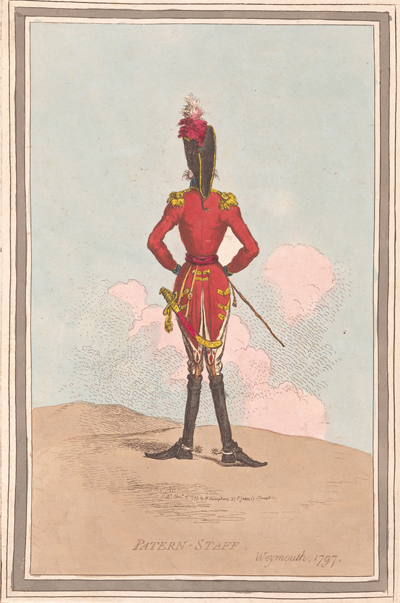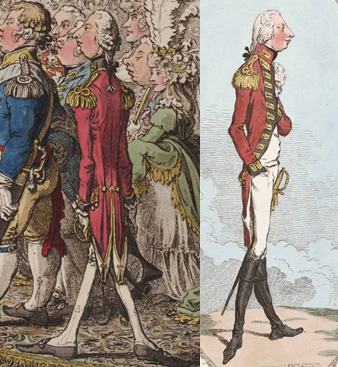Patern-Staff. Weymouth, 1797
As the British Museum commentary suggests, this delightfully economic print is almost certainly a portrait caricature of Prince William, the future Duke of Gloucester, NOT Viscount Weymouth, as Wright and Evans suggest.

© Beinecke Rare Book and Manuscript Library, Yale University
Gillray had already caricatured the Prince in The Bridal Night (1797) and A Slice of Gloster Cheese (1795) In both, Gillray had portrayed him as painfully thin (his nickname was "Slice"), knock-kneed, and splay-footed, just as the figure in Patern Staff. And since the Royal Family had just spent their 1797 vacation at the "Gloucester Lodge" belonging to William's father, in Weymouth, Gillray would naturally have associated the 21 year old Prince with Weymouth.

© Lewis Walpole LIbrary, Yale University
Gillray places him on an eminence, like so many of Gillray's military personnel. But in this case, there are no bloody battlefields, no conquered towns with flames arising in the background. His pose is not the relaxed and graceful stance of some classical model— an Appollo Belvedere or a Caesar Augustus—but an absurdly regular collection of straight lines and sharp angles. (The "pattern" in "Patern Staff.") And as he faces away from us looking out over a vast abyss of nothing, we may be reminded that his cousins referred to him as "Silly Billy."
Sources and Reading
- Commentary from the British Museum on Patern-Staff. Weymouth, 1797.
- "Prince William Frederick, Duke of Gloucester and Edinburgh," Wikipedia
- Janice Hadlow, A Royal Experiment, Ch. 12 Three Weddings, 2014.
- Thomas Wright and R.H. Evans, Historical and Descriptive Account of the Caricatures of James Gillray #474
- Thomas Wright and Joseph Grego, The Works of James Gillray, the Caricaturist; With the History of His Life and Times p. 231.
Comments & Corrections
NOTE: Comments and/or corrections are always appreciated. To make that easier, I have included a form below that you can use. I promise never to share any of the info provided without your express permission.